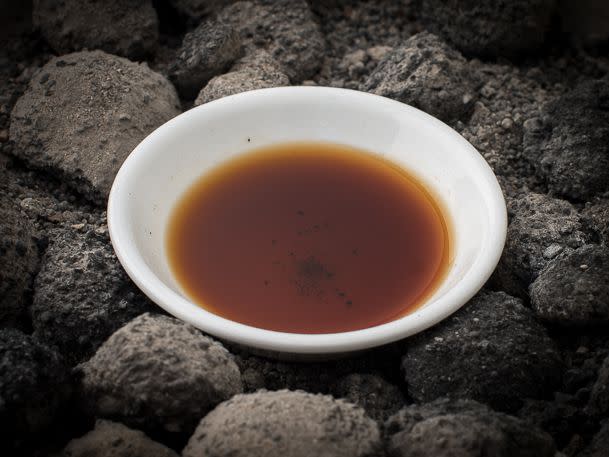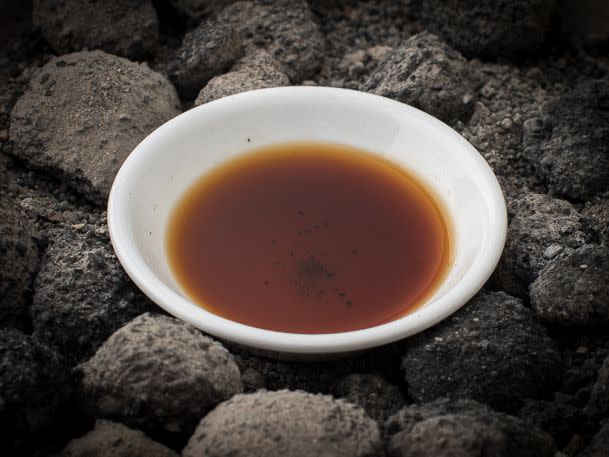Pantry Essentials: All About Liquid Smoke
Liquid smoke replicates the flavor of smoke-curing without all the hassle.

"Black liquid trickling down the side of a stove-pipe." Those unappetizing words, offered by a 1923 edition of the Rotary Club's official magazine The Rotarian, is how one publication describes the inspiration for Ernest H. Wright's culinary invention: liquid smoke. And while the use of the ingredient today may inspire some controversy, it has a fascinating history that helps put its popularity into context.
"it replicates the flavor produced by smoke-curing without actually requiring you to smoke anything."
Previously I wrote about liquid seasonings, a diverse category of brown liquids that add a dash of savory flavor to a dish. Liquid smoke could be counted in the same category, but I think it stands apart because it does such a very specific job. As the name suggests, liquid smoke is a liquid that tastes like smoke—it replicates the flavor produced by smoke-curing without actually requiring you to smoke anything.
The origins of liquid smoke date back to the end of the 19th century, at a time when the experience of cooking food over an open flame was perhaps less limited to campfires and summer barbecues, and smoke-curing was done out of necessity rather than for the flavor. Smoke has natural bacteria-killing properties that keeps food edible for longer.
"Smoky" belongs to that category of now-sought-after food flavors that began as a side-effect of preservation, alongside pickling, sugaring, and salting. Whichever method was used to keep food safe through the lean seasons inevitably became part of the local palette, an expected flavor that people sought out.
Liquid smoke does have some of the same bactericidal properties as real smoke, yet it seems its inventor intended it at least as much as a flavor enhancer, and it's a safe bet that it's mostly used to that end today, now that much more effective food preservation methods are available.
"tested his new "condensed smoke" by coating a ham and serving it to his unsuspecting friends."
As reported in the Rotarian, Wright, a chemist in Missouri, conceived of the idea of liquid smoke after recalling that aforementioned trickle of black liquid down a stovepipe. Smoke rising from a stove would hit the cold air and collect in droplets that ran back down the pipe. Wright experimented with a way to replicate the process, and tested his new "condensed smoke" by coating a ham and serving it to his unsuspecting friends.
The product was a hit, and Wright soon went from distributing his product to rural farms to setting up business in Kansas City and shipping the product across the country. At first he was the only manufactuerer of liquid smoke, and he refused to patent the product for fear that writing his secret formula down would allow others to copy him.

Serious Eats / Paul Hillier
In due course other companies cracked the method. Liquid smoke really is made from smoke. Chips or sawdust from hardwoods such as hickory or mesquite are burned at high temperatures, and particles of the smoke are collected in condensers. The resulting liquid is concentrated down for a stronger flavor.
When shopping for liquid smoke, be aware that some brands add seasonings, flavourings like molasses or vinegar, or colorants like caramel. Liquid smoke should just be smoke and water, and there are brands that are exactly that simple. Wright's, a favorite here at Serious Eats, is available in both hickory and mesquite varieties and contains nothing but water and natural smoke flavor. Check the label to make sure you're getting what you want from your liquid smoke. It's an easier product to use when you don't have to worry about how its other ingredients might alter the flavor of your food.
If you're feeling adventurous you can also make your own liquid smoke. You can do what Serious Eats' Chief Creative Officer Kenji did over at Cook's Illustrated Magazine (paywall link) using a kettle grill and a lab-grade condenser, or follow Alton Brown's method using a chimney, a bundt pan, and a bag of ice. Both methods produce results that are superior to what you can get in stores.
Because it contains real smoke, liquid smoke also contains carcinogens. Modern manufacturers reportedly filter most of these out, and it's generally considered safe to use in moderation. Indeed, such is the intensity of its flavor that you should only want to use it in moderation! Some cooks have complained of a chemical flavor when using liquid smoke, but that's usually a sign that you've used too much.
"Liquid smoke is widely used in commercial food production wherever a smoky flavor is expected"
If you decided to remove liquid smoke from your diet, it would be trickier than simply not buying a bottle. Liquid smoke is widely used in commercial food production wherever a smoky flavor is expected—for example, smoky bacon generally hasn't been smoked at all; it's just had liquid smoke added. The same is true for a lot of smoked cheeses, smoked tofu, and even jerky.
Should you decide to use the bottle in your own pantry, an easy option is chili, where a touch of hickory flavor is very welcome. It's also good used sparingly in brisket or pulled pork, or in a bean stew or soup. As you might imagine it's a slow cooker's best friend, adding a dimension of flavor to those dishes that the slow cooker itself simply cannot provide. It can be added to brines and marinades to offer a light smoky flavor, or brushed directly on to burgers or sandwich meats.
Store your liquid smoke tightly sealed in its original dark glass bottle in a cool, dark place and it should keep its flavor and aroma almost indefinitely. Whenever using it, remember that moderation is key. Too much will quickly overpower your dish and add that unwanted acrid chemical flavor.
Also, try to put all thoughts of black liquid trickling down a stovepipe out of your head!
